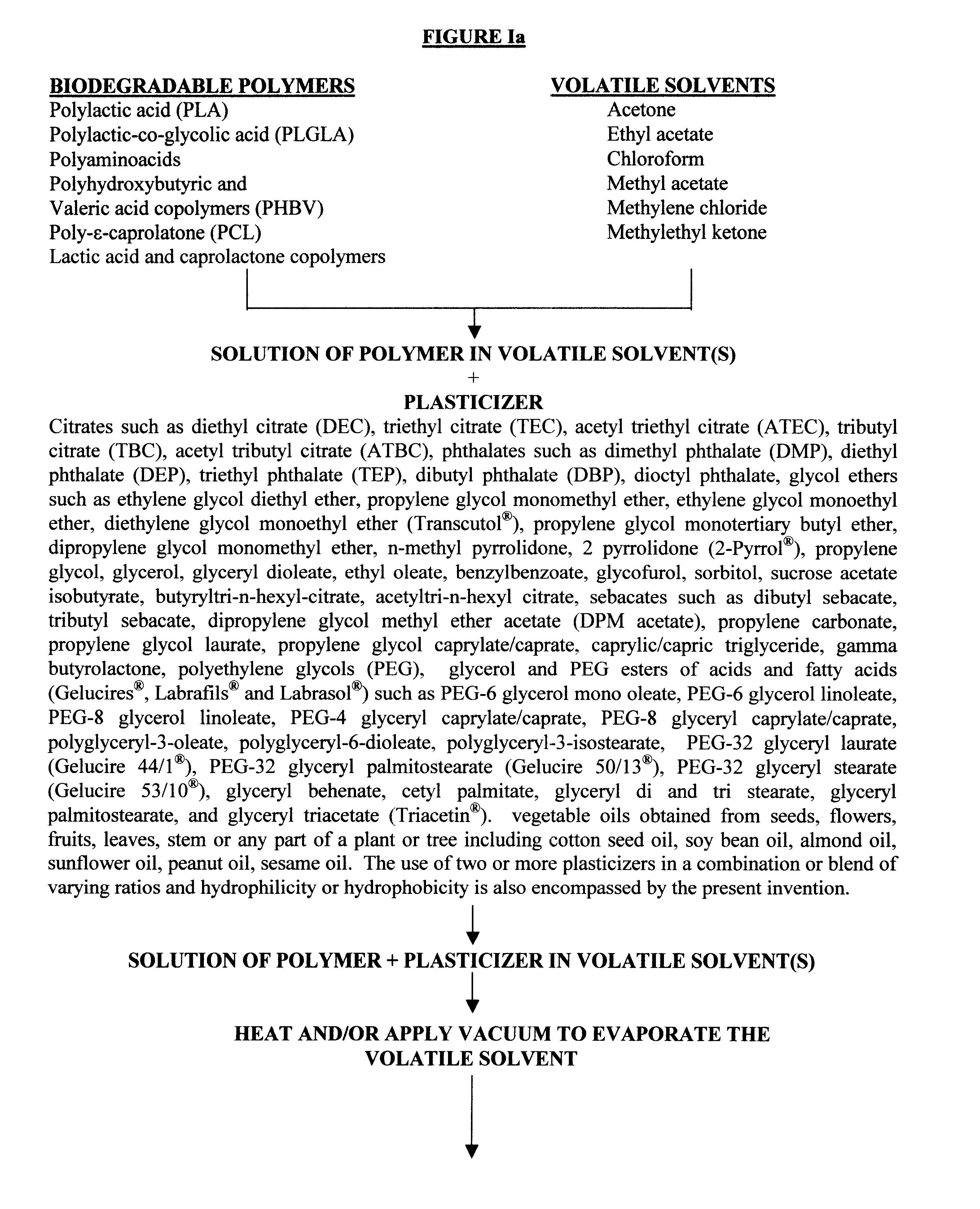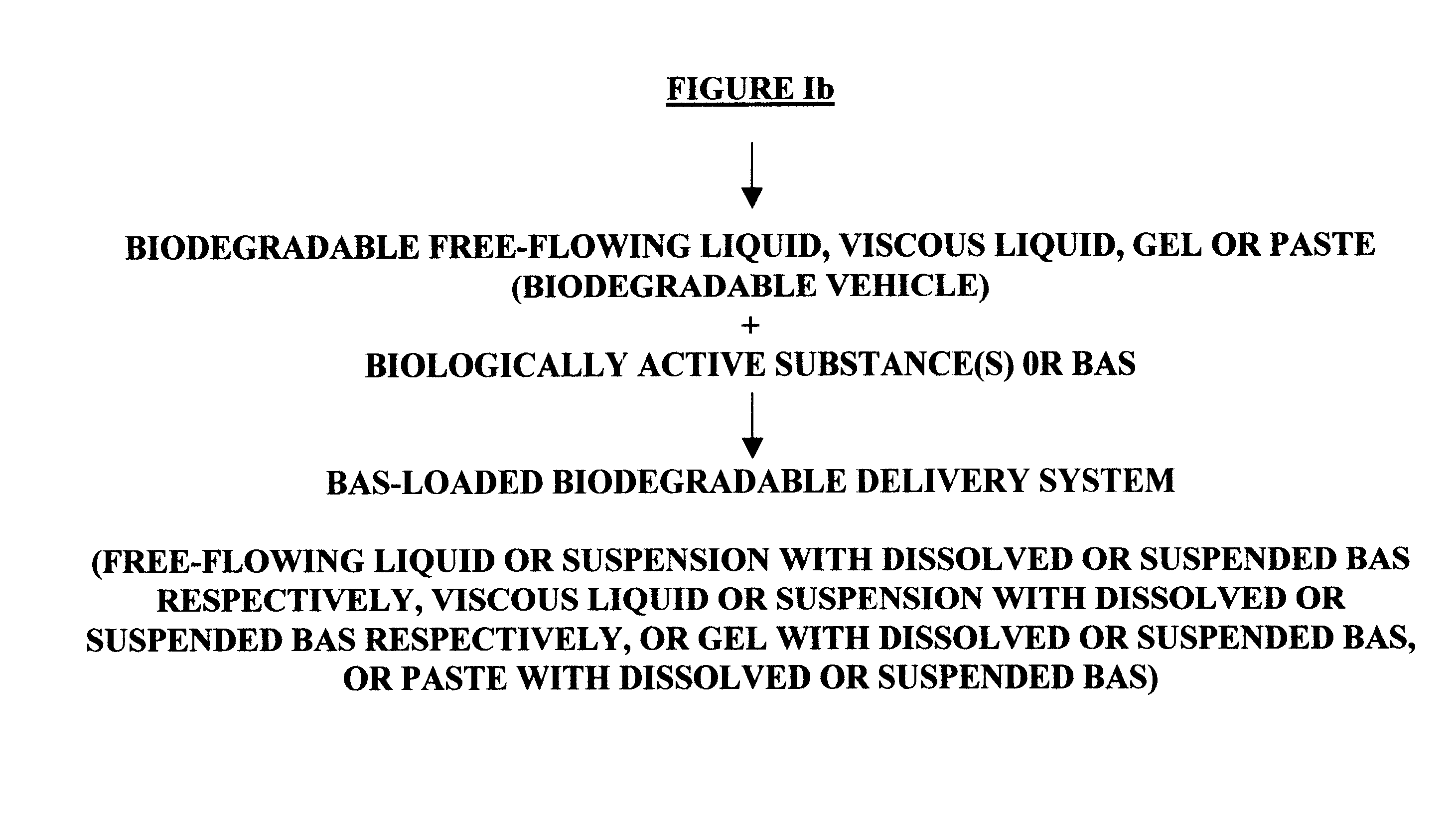The present invention relates to methods for preparing a biodegradable vehicle. It also describes the composition of the biodegradable vehicle and the process of blending one or more BAS with the biodegradable vehicle just prior to its use. Keeping the BAS separated from the biodegradable vehicle can enhance the stability of the BAS. Moreover, the
dose of BAS (BAS-loading) can be tailored by varying the ratio of the biodegradable vehicle to the BAS. An appropriate quantity of one or more BAS, as required by the
end user, is blended with the biodegradable vehicle just prior to use. Mixing of the BAS with the biodegradable vehicle can be accomplished by simply stirring the mixture with a stirring device, or by triturating the no mixture or employing an ointment mill or a suitable device or apparatus or equipment that can be used for blending / mixing. Alternatively, a device, which resembles two syringes or
syringe-like devices (e.g. pumps in which materials can be mixed by depressing a trigger-like device) attached together with a removable partition or a valve
assembly can also be used to uniformly mix the BAS with the biodegradable vehicle. The BAS is loaded in one
syringe or compartment and the biodegradable vehicle is loaded in the other compartment. A removable partition or a valve, which will allow the contents of the two compartments to be mixed uniformly, separates the two compartments. The mixing process is performed in order to dissolve or uniformly suspend the BAS particles in the biodegradable vehicle. The biodegradable vehicles can be free-flowing or
viscous liquid, gel or paste. The method of manufacturing the biodegradable vehicle described in the present invention involves dissolving one or more biodegradable polymers and one or more plasticizers in a volatile
solvent or mixture of
volatile solvents. The volatile
solvent is then removed using vacuum or evaporated at an elevated temperature, or removed using both vacuum and elevated temperature. The biodegradable vehicle could be sterilized in the final packaging by an appropriate technique including
irradiation sterilization technique. Alternatively, the biodegradable vehicle can be prepared from pre-sterilized components in an aseptic environment. Sterilization of the solvents and plasticizers used in the manufacturing process could be accomplished by an appropriate sterilization technique such as
filtration, autoclaving or
irradiation. The sterilized biodegradable vehicle is blended with appropriate quantities of one or more BAS just prior to its use.
Advantages of the biodegradable vehicle described in the present invention include the flexibility of tailoring the
dose of the BAS in the
system by blending the requisite amount of BAS and the biodegradable vehicle just prior to its use, and enhancing stability of the BAS since it is blended with the biodegradable vehicle just prior to its use. A major reason for the enhanced stability of the BAS is that the BAS is not subjected to
exposure to solvents, chemicals or the harsh
processing conditions during the manufacture of the biodegradable vehicle. Moreover, the BAS is stored in an appropriate separate container; hence it does not come in contact with the biodegradable vehicle until it is blended with the vehicle just prior to use.
According to the present invention, the term
polymer includes
oligomer, copolymer and terpolymer. Biodegradable polymers are used in this invention because they form vehicles that can degrade
in vivo into non-toxic degradation products. Moreover, these polymers are available in varying physicochemical properties including varying hydrophilicity and hydrophobicity, varying molecular weights, varying
crystallinity and amorphous states and varying copolymer ratios. Tailoring either the degradation
kinetics of the biodegradable vehicle or the release characteristics of the BAS from the BAS-loaded biodegradable vehicle can be easily achieved by varying several factors including, the consistency or
rheology of the vehicle, BAS-loading, polymer molecular weight, hydrophilicity or hydrophobicity of the plasticizer, copolymer ratio, polymer to plasticizer ratio.
The present invention relates to methods for preparing a biodegradable vehicle. It also describes the composition of the biodegradable vehicle and the process of blending one or more BAS with the biodegradable vehicle just prior to its use. The BAS loading can be varied by varying the ratio of the biodegradable vehicle to the BAS. Moreover, keeping the BAS separated from the biodegradable vehicle in the present invention can enhance the stability of the BAS. The BAS is blended with the biodegradable vehicle just prior to use. The biodegradable vehicle can be free-flowing or viscous liquids, gels or pastes. The method of manufacturing the biodegradable vehicle described in the present invention involves dissolving one or more biodegradable polymers and one or more plasticizers in a volatile
solvent or mixture of
volatile solvents. The volatile solvent is then removed using vacuum or evaporated at an elevated temperature, or removed using both vacuum and elevated temperature.
Advantages of the biodegradable vehicle described in the present invention include the flexibility of tailoring the BAS loading in the
system by blending the requisite amount of one or more BAS and the biodegradable vehicle just prior to its use, and enhancing stability of the BAS since it is blended with the biodegradable vehicle just prior to its use. Another major reason for the enhanced stability of the BAS is that the BAS is not subjected to
exposure to solvents, chemicals or the harsh
processing conditions during the manufacture of the biodegradable vehicle. Moreover, the BAS is stored in an appropriate separate container; hence it does not come in contact with the biodegradable vehicle until it is blended with the vehicle just prior to use. The BAS can be present either in the
solid state,
liquid state (where the BAS is dissolved in the plasticizer or blends of plasticizers), or as a suspension (where the BAS is suspended in the plasticizer or blends of plasticizers) in an appropriate container separated from the biodegradable vehicle. The BAS could also be present in the dissolved or a suspended state in a
viscous liquid, semi-
solid or gel or a paste form of a plasticizer or blends of plasticizers in a separate container.
 Login to View More
Login to View More 


